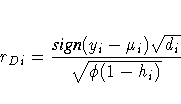Residuals
The GENMOD procedure computes three kinds of residuals.
The raw residual
is defined as

where yi is the ith response and
 is the corresponding predicted mean.
is the corresponding predicted mean.
The Pearson residual
is the square root of the ith
contribution to the Pearson's chi-square.

Finally, the deviance residual
is defined as the square root of the contribution of the ith
observation to the deviance, with the sign of the raw residual.

The adjusted Pearson, deviance, and likelihood
residuals are defined by Agresti (1990),
Williams (1987), and Davison and Snell (1991).
These residuals are useful for outlier
detection and for assessing the influence
of single observations on the fitted model.
For the generalized linear model, the variance
of the ith individual observation is given by

where  is the dispersion parameter, wi is a
user-specified prior weight (if not specified, wi=1),
is the dispersion parameter, wi is a
user-specified prior weight (if not specified, wi=1),
 is the mean, and
is the mean, and  is the variance function.
Let
is the variance function.
Let

for the ith observation, where  is
the derivative of the link function, evaluated at
is
the derivative of the link function, evaluated at  .Let We be the diagonal matrix with
wei denoting the ith diagonal element.
The weight matrix We is used in
computing the expected information matrix.
.Let We be the diagonal matrix with
wei denoting the ith diagonal element.
The weight matrix We is used in
computing the expected information matrix.
Define hi as the ith diagonal element of the matrix
-
We(1/2) X (X' We X)-1 X' We(1/2)
The Pearson
residuals, standardized to have unit
asymptotic variance, are given by

The deviance
residuals, standardized to have unit
asymptotic variance, are given by

where di is the square root of the contribution to the total
deviance from observation i, and sign is 1 if
is 1 if
 is positive and -1 if
is positive and -1 if  is negative.
The likelihood
residuals are defined by
is negative.
The likelihood
residuals are defined by

Copyright © 1999 by SAS Institute Inc., Cary, NC, USA. All rights reserved.







